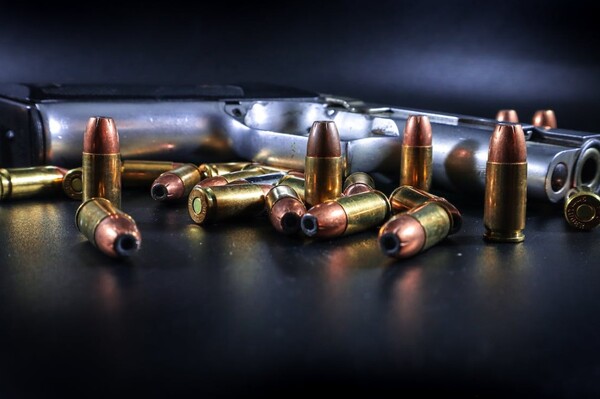
(function(d, s, id) { var js, fjs = d.getElementsByTagName(s)[0]; if (d.getElementById(id)) return; js = d.createElement(s); js.id = id; js.src = “https://connect.facebook.net/en_US/sdk.js#xfbml=1&version=v3.0”; fjs.parentNode.insertBefore(js, fjs); }(document, ‘script’, ‘facebook-jssdk’)); –>
–>
December 8, 2023
As we watch another case on firearms go to the U.S. Supreme Court, this one with ancillary political pressure, it is interesting to look at the pace of recent cases versus the dearth of Second Amendment cases historically. One would think such a hotly debated topic would be rife with judicial interventions on a routine basis, but that is just not the case.
‘); googletag.cmd.push(function () { googletag.display(‘div-gpt-ad-1609268089992-0’); }); document.write(”); googletag.cmd.push(function() { googletag.pubads().addEventListener(‘slotRenderEnded’, function(event) { if (event.slot.getSlotElementId() == “div-hre-Americanthinker—New-3028”) { googletag.display(“div-hre-Americanthinker—New-3028”); } }); }); }
It is instructive to look at history in terms of both numbers and results. This list is fairly exhaustive but notably excludes discussion of cases relying on the commerce clause of the Constitution and some cases where Second Amendment protections were mentioned in decisions on other issues of law but did not directly address the right to bear arms.
Beginning in the post-1860s turmoil of the Civil War, we see the first significant case, U.S. v. Cruikshank, 1875, which was technically a civil rights case, where the Court ruled that the Constitution bars the actions of Congress, not the actions of private citizens, in depriving freed slaves of their civil rights. This is an unconscionable decision today, but apparently, it was in keeping with the times. While not addressing gun rights specifically, it was the refusal of the KKK to allow freed slaves to be armed that brought the case before the Court. Subsequent legislation would nullify this ruling, but that legislation would not and does not address the action of politicians as a criminal violation.
Dred Scott is notable in this same vein. A case that denied the citizenship rights of “free negroes” also addressed the 2nd Amendment, by noting it as a right of all free men: “and it would give them the full liberty of speech in public and in private upon all subjects upon which its own citizens might speak; to hold public meetings upon political affairs, and to keep and carry arms wherever they went.”
‘); googletag.cmd.push(function () { googletag.display(‘div-gpt-ad-1609270365559-0’); }); document.write(”); googletag.cmd.push(function() { googletag.pubads().addEventListener(‘slotRenderEnded’, function(event) { if (event.slot.getSlotElementId() == “div-hre-Americanthinker—New-3035”) { googletag.display(“div-hre-Americanthinker—New-3035”); } }); }); }
In Presser v. Illinois, 1886, SCOTUS ruled that the 2nd Amendment is a right of individuals, not the right of militias. The case addressed whether there is a constitutional right of citizens to form private or community military organizations, and the Court ruled that there is not. This is the first ruling where the 2nd Amendment is recognized as a personal individual right, although the Court gets to it through a back door. Regardless of the Court’s intent, the ruling clearly sets a precedent that had not previously been set, at least not by the High Court.
The Court would stand moot on this issue for the next 50 years. Then, influenced by its previous ruling in Presser, it produced a ruling in support of the National Firearms Act of 1934 (NFA). U.S. v. Miller is the most interesting ruling in Second Amendment history. Miller was charged with owning a shotgun with a barrel shorter than eighteen inches and without paying the requisite tax on that firearm, a violation of the 1934 NFA. Miller relied upon the 2nd Amendment, but the Court ruled that there was no history of short-barreled shotguns being used in military service, and that type of firearm therefore is not covered by the 2nd Amendment. The resulting test indicates that guns that are commonly used or at least suitable for use in military service are covered by the 2nd Amendment, whereas others are not. In the common era of chants for bans, this decision protecting only weapons of war is rarely discussed.
It is interesting that the NFA was the nation’s first legislative attempt to restrict gun ownership for all citizens and residents of the U.S., and it has stood for 90 years without being specifically addressed by the Court, aside from this one case. Nor has the Court addressed the legality of taxing a constitutional right, essentially making that right more protected for higher socio-economic classes than the common man.
It is nearly 70 years before we see another significant Supreme Court ruling directly addressing the 2nd Amendment: D.C. v. Heller, 2008, where the Court essentially upheld its 1886 ruling that keeping arms is an individual right.
Only two years later, in McDonald v. Chicago, 2010, the Court ruled that the 14th Amendment incorporates the 2nd Amendment in its protections and that the States are prohibited from infringing the 2nd Amendment, just as Congress is. In 2020, we have a footnote, where the City of New York attempted similar infringement but repealed its law before the Courts could rule on its constitutionality, effectively depriving the citizens of what would have almost certainly been another ruling that barred government from violating individual rights.
This brings us to the most recent case, New York State Rifle and Pistol Association, Inc. v. Bruen, where the Court ruled in 2022 that N.Y. could not assume that the right to bear arms applies only to the home. The Court stopped just short of finding actions by the States to permit a constitutional violation but essentially disallowed all permitting not based on “shall issue” premise. In short, permitting schemes using any criteria other than a background check are not allowed by the new ruling. This seems straightforward, but the language of the Court has fueled angst for certain judges. The dilemma seems to be linked to a “new standard” for judicial review of firearm laws that requires that modern laws be “consistent with this Nation’s historical tradition of firearm regulation.”
‘); googletag.cmd.push(function () { googletag.display(‘div-gpt-ad-1609268078422-0’); }); document.write(”); googletag.cmd.push(function() { googletag.pubads().addEventListener(‘slotRenderEnded’, function(event) { if (event.slot.getSlotElementId() == “div-hre-Americanthinker—New-3027”) { googletag.display(“div-hre-Americanthinker—New-3027”); } }); }); } if (publir_show_ads) { document.write(“
It is of interest that what is one of the most hotly assaulted civil rights as guaranteed by the U.S. Constitution has been before SCOTUS only six times, and half of those were within the last 15 years, with the seventh case being heard on November 7, U.S. v. Rahimi.
The NFA itself has yet to be challenged at the SCOTUS level, nor has any modification in the bill been challenged. The 1986 machine gun ban has been tested in the lower courts, but it has been upheld only under provisions of the commerce clause of the United States Constitution. In fact, in 1991, the U.S. District Court for Central Illinois ruled in U.S. v. Rock Island Armory that the possession of a machine gun cannot be prosecuted under the provisions of the National Firearms Act but allowed a conviction to stand under the commerce clause. Although not an appellate precedent, the decision was not challenged, probably to avoid a precedent that certain factions would find contrary to efforts to disarm the population.
Now the Biden administration brings the case of Rahimi, a domestic abuser, because he is an attractive person to deny constitutional rights, given his history of alleged abuse and an active restraining order, which the administration obviously feels provides an opportunity to obtain a precedent for restricting rights. The question, however, is whether a conviction is required to meet the burden of denying rights. Perhaps of more interest is that, although not relevant to the actual case, Rahimi is accompanied by pressure from the left to relieve the Judiciary of the burden of stare decisis and the “confusion” ensuing from the Bruen decision.
The Second Amendment is clearly written, in eighth-grade English, and the only perceived uncertainty is the reference to militias, which is actually an argument of syntax. Even if that issue had merit, it has been resolved with crystal-clear precedent since Presser in 1886. It is puzzling, then, how Bruen, directing the Judiciary to reference such a clear line of precedent, has created such a dilemma for certain members of the Judiciary. In fact, consistency in the application and interpretation of law is perhaps the most required of philosophical tenets in the validation of Western jurisprudence.
The Courts do not randomly change positions on law. Murder is illegal; it has always been illegal. While procedural issues on admissibility and validity of evidence, the rules of the courts regarding process, or even the penalties may change, the law making the taking of a human life with malice aforethought illegal remains consistent throughout the history of the nation and even before the U.S. was a nation. Likewise, the elements of a valid contract are essentially unchanged since the nation’s founding, so this reliance on historical decision is not new, or, as some have claimed, “out of left field.” In fact, the premise is so well ingrained that lawyers even have a name for it, stare decisis, which legaldictionary.com defines as “let the decision stand.” The “doctrine of precedent” is indeed the heart of the entire common law system. Yet we have cries to single out this issue and not apply precedent because it creates uncertainty and a need for research.
If we look at the body of law and the decisions of SCOTUS, what we see is a clear line of precedent, where SCOTUS has repeatedly pushed the states and the Congress back into line. Unlike many constitutional issues, including the First Amendment, the Court has never waffled on this issue at all. None of these decisions, with perhaps the exception of Miller, has served to limit the rights of Americans; they have all served to limit the right of government to infringe that which the Second Amendment says may not be infringed. After decades of letting sleeping and somewhat rabid dogs lie, it seems the Court is actively engaged in its primary job of protecting citizens from government overreach on this issue.
Perhaps the time is right to see a decision on the constitutionality of the NFA, as many of the firearms, like short-barreled rifles, do in fact have military application in 2023 and, as such, meet the test prescribed in Miller. One can persuasively argue that fully automatic weapons, so called machine guns, have always met the Miller test and should never have been banned in 1986 or taxed in 1934, as the courts did in Rock Island Armory.
The Court carefully and perhaps judiciously avoided a direct ruling on the assault weapons ban of 1994 by simply ignoring questions related to the ban in the several cases brought before it. This era of avoidance seemed to terminate with Heller, so perhaps a ruling will be forthcoming as multiple states attempt to ban “assault weapons.” At the time of this writing and since Bruen, bans have been both upheld and overruled by the federal courts, have received similar mixed results in the appellate courts and seem destined for SCOTUS.
Given the 150-year history of Second Amendment decisions, the most prudent move for the anti-gun movement might be to avoid further decisions from this Court. Any expectation that the same Court will reverse a position it reached only two years ago seems unlikely in the extreme.

Image via Pexels.
<!–
–>
<!– if(page_width_onload <= 479) { document.write("
“); googletag.cmd.push(function() { googletag.display(‘div-gpt-ad-1345489840937-4’); }); } –> If you experience technical problems, please write to [email protected]
FOLLOW US ON
<!–
–>
<!– _qoptions={ qacct:”p-9bKF-NgTuSFM6″ }; ![]() –> <!—-> <!– var addthis_share = { email_template: “new_template” } –>
–> <!—-> <!– var addthis_share = { email_template: “new_template” } –>





